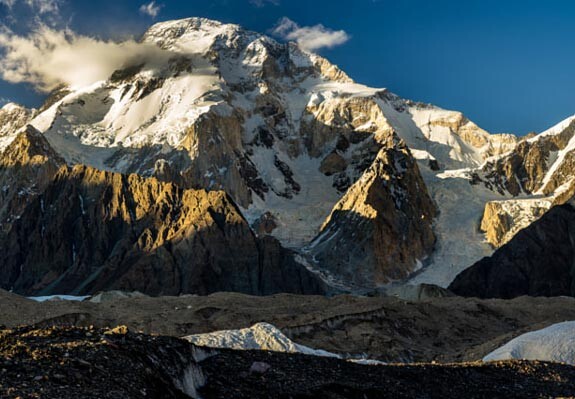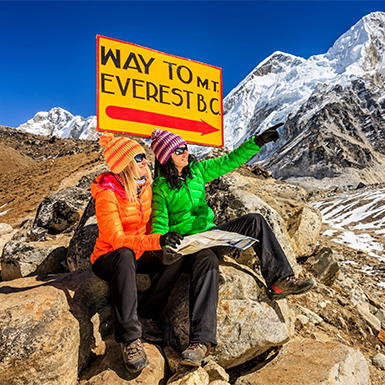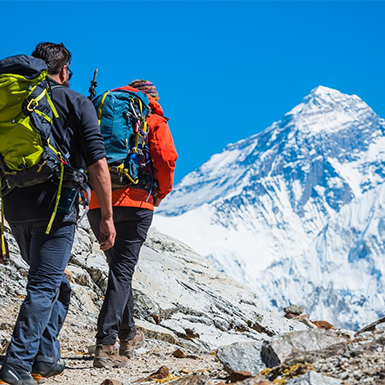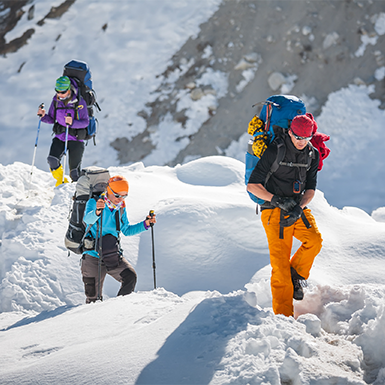Hello readers,
Before sharing my Everest Base Camp trekking experience, I’d like to introduce myself briefly. I have been a trekking and tour leader for twelve years, specializing in the Annapurna and Everest regions with Peregrine Treks and Tours.
I take great pride in working for Peregrine Treks and Tours, the leading travel company in Nepal with the most significant international network. They offer a wide range of outdoor activities in Nepal, Tibet, and Bhutan and have a history of twenty-five years of satisfying hundreds of thousands of adventurers worldwide.
The organization is very humble and takes good care of its employees. Moreover, they provide various training and grants with fun travel vacation options. Hence, I got fortunate to choose the Everest Base Camp trek free of cost.
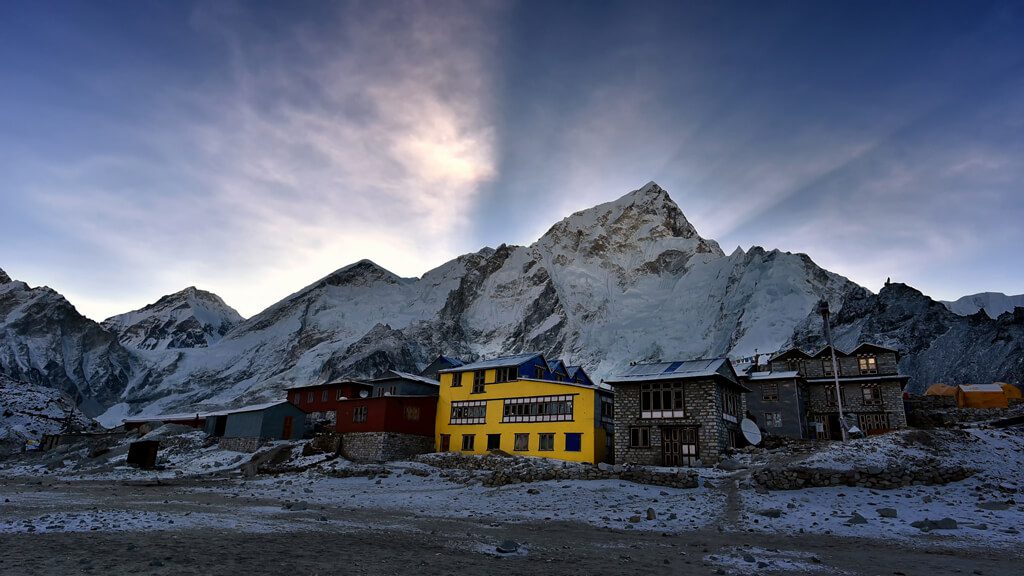
The Everest Base Camp trek is one of the most popular spots in Nepal, offering a wide range of stunning natural scenery. The trek begins from flat terrain and gradually increases in elevation, with abundant vegetation. You’ll pass through various Sherpa villages, Buddhist monasteries, museums, and dynamic prayer wheels.
Crossing several suspension bridges, walking along river banks, and climbing steep steps were some of the incredible challenges I experienced during the trek. After walking 6-7 hours a day, we rested in the evening at cozy tea houses serving the most delicious meals. Sitting beside a warm fireplace in the dining room and sharing knowledge and travel experiences with fellow trekkers added to the overall experience.
The EBC trek offered breathtaking views of Mt. Everest and other surrounding peaks, and encountering the rich natural charm of the area was a definite perk. The Solukhumbhu inhabitants’ hospitality, compassion, and way of existing were also memorable highlights of the trek.
Related Post
My Everest Base Camp Trek Experience
Day 1: Fly to Lukla from Kathmandu and trek to Phakding
Our Everest Base Camp trek started with a 25-minute mountain flight to Tenzing-Hillary Airport in Lukla. After landing, we stopped at Mira Lodge for breakfast and walked toward Phakding. On the way, we crossed a suspension bridge and passed various Chortens, Mani stones, and colorful prayer flags. We also enjoyed the sight of beautiful peaks such as Karyolung (6511 m), Nupla (5885 m), and Gongla (5813 m).
After a few hours of walking, we took a break to refresh tea at Thado Koshi, where we also saw Mt. Kusum Kangaru (6367 m) standing behind the Koshi River. We then resumed our journey toward Phakding, which took us about an hour to reach. Upon arrival, we had our lunch and stayed overnight in Shangri-la Lodge. In the late afternoon, we explored the oldest monastery in the region, Pema Choling Gompa, which has a history of 350 years.
Some Facts:
Many of the houses in Phakding village are painted with white clay, which gives the village a distinctive appearance. This is because there used to be a source of white micaceous clay in the area, and the villagers used it to paint their houses. As a result, the village came to be known as Phakding.
In addition, the Pema Choling Gompa in Phakding is also known as Rimishung Gumba. It is the oldest and most important Gompa (monastery) in the Khumbu region, dating back 350 years.
Day 2: Trek to Namche Bazaar
On this day of our trek, we encountered semi-moderate trails. We began with a challenging climb to Namche Bazaar for about two and a half hours. We crossed four suspension bridges and followed the Dudh Koshi River during this climb. We walked along narrow stone paths, where our TIMS permit was checked, and we took a break for tea. As we continued, we passed many Chortens, mani stones, and greenhouses, and we caught glimpses of Mt. Kongde (6168 m), Kusum Kangaru (6367 m), and Mt. Thamserku (6608 m).
Next, we arrived at Monjo, the last village before the Sagarmatha National Park. We showed our National Park permit and continued our trek, which included some uphill and downhill trails, finally stopping in Jorsalle for lunch. After our meal, we walked for over two and a half hours, crossing the Hillary Bridge and catching our first glimpses of Mount Everest, Lhotse, and Nuptse on our way to Namche Bazaar.
Namche Bazaar is renowned as the heart of the Khumbu region and is home to the largest Sherpa settlements in Nepal. We spent the night in this ancient valley to acclimatize, staying at the Snow Land Lodge.
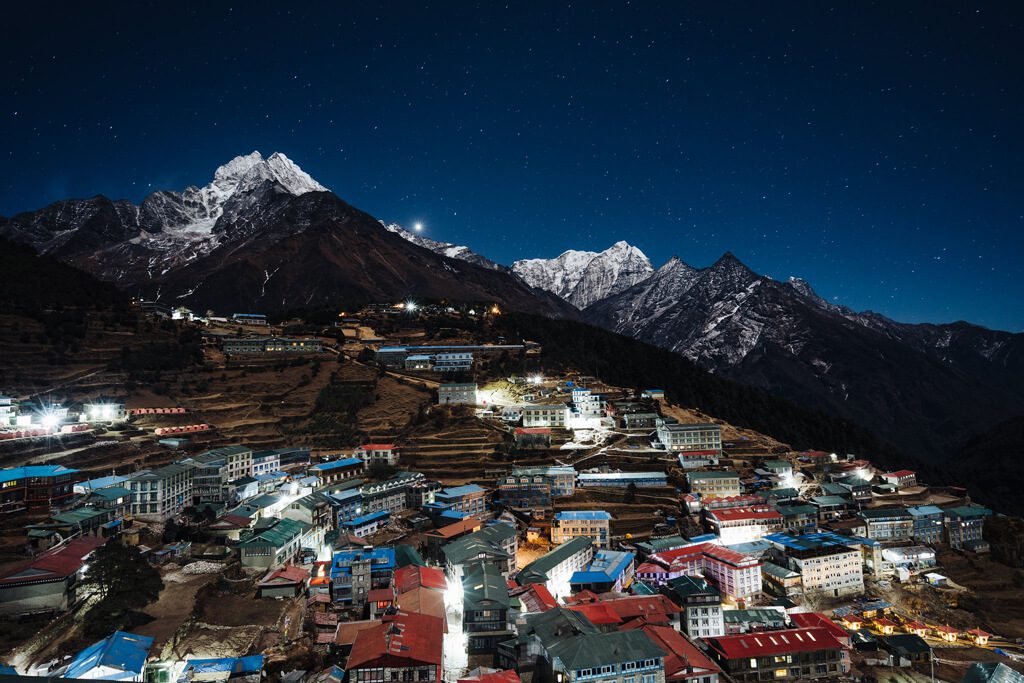
Day 3: Acclimatization Day in Namche Bazaar
On this day, you took a break from ascending to acclimatize your body to the altitude. After having breakfast, you went for a short hike to Syangbuche, which took about two and a half hours. The trail was rocky and steep. At the top, you reach an altitude of 3880m and enjoy a 360-degree view of the surrounding mountains. You can identify several famous peaks, including Mt. Everest, Lhotse, Nuptse, and Amadablam.
You stopped at the Everest Sherpa Resort for tea, which was a memorable experience. After an hour of enjoying the beautiful scenery and famous Nepalese tea, you hiked back to your lodge and had lunch. You spent the rest of the afternoon resting and went shopping in the evening.
Some facts:
- You can see a remote mountain on the right side of Mt. Kongde. Its name is Mount Khumbila.
- Behind it is a small village popularly known as a green valley. Many years ago, people painted their house’s roofs with white sparkle zinc.
- As a result, the reflection of sunlight caused all snowmelt in Khumbila Mountain. Later, people realized the effects of white zinc and replaced the roof with green.
- After that, villagers called it Green Valley. Besides, Khumbila is a sacred mountain restricted from climbing.

Day 4: Trek to Tengboche
Tengboche is famous for its Tengboche Monastery, the largest monastery in the Khumbu region. The monastery was built in the 1920s and has since undergone multiple renovations. It is an important religious site for locals and tourists, and visitors can attend daily morning and evening prayers. The monastery also hosts the Mani Rimdu festival, a three-day festival celebrated every October or November.
From Tengboche, we could see panoramic views of the mountains, including Everest, Lhotse, Nuptse, and Ama Dablam. The village is also a popular trekking stop, and several lodges and tea houses are available for accommodation. We spent the evening relaxing, enjoying the stunning views, and preparing for the next trek.
Sighting awe-inspiring mountain views of Everest, Amadablam, Lhotse, and Thamserku lured us to go closer and touch them. Lastly, we visited 104 years old Tengboche Monastery and returned to the tea house.
Some facts:
- A total of sixty monks live in the Tengboche Monastery. Those monks were disciples of Guru Rinpoche.
- Mani Rimbu, Lama Sanga Dorje, Lama Gulu, Kalachakra, prayer wheels, and thangkas inside the monastery.
Day 5: Trek to Dingboche
On this day, we were set to climb over 4000 meters, and the trekking route was relatively easy. As we ascended, we noticed a change in vegetation – the trees became sparse, and the air thinner and windier. After breakfast in Tengboche, we began our trek, walking down evenly into the rhododendron forest along the Dudh Koshi River. Along the way to Lower Pangboche, we crossed an iron bridge, Mani stone, and a conifer forest. We continued trekking, taking a lunch break at Syomare, and crossed the tree line. We could see stunning mountain views and many Yaks and Naks grazing on the grassy slopes.
After walking for about 6 hours, we finally reached Dingboche and stayed at the Hotel Peaceful Lodge. Dingboche village used to be a summer settlement for transhumance herders. We could see views of peaks from the town, such as Lhotse, Amadablam, Imjatse, and Taboche.
Day 6: Acclimatization day at Dingboche
On our second acclimatization day, we planned to hike for a few hours after breakfast before returning for lunch. We walked up to Chukung’s height, which is at an altitude of 4735 m and is considered the gateway to Island Peak, making it a suitable place for acclimatization.
Our stroll allowed us to catch breathtaking views of Mount Makalu, Island Peak, Baruntse, Amphula, Nuptse, Tabuche, and Lhotse. Additionally, we were lucky enough to encounter several species of birds, including the Himalayan Raven, Himalayan Vulture, Common Kestrel, and Yaks and Naks.
While observing the Yaks and Naks, we couldn’t help but wonder how remarkable it was for these animals to survive at such high altitudes. After our hike, we returned to our tea house for lunch, where we enjoyed the sunny weather and panoramic mountain views while sipping on hot drinks to keep warm.
Day 7: Trek to Lobuche
After departing from Dingboche, we ascended a grassy slope where Yaks and Naks could still be observed grazing. We stopped for a tea break at Thukla before continuing our climb for an additional hour, which presented a challenge for us. Along the way, we encountered several Chorten, constructed in honor of courageous climbers who had attempted to summit Mount Everest and other neighboring peaks.
Recalling a few Chorten named after renowned mountaineers Hristo Prodanov and Babu Chiri Sherpa, who had lost their lives after reaching the peak, we paid homage to all valiant climbers and proceeded towards our destination. After an hour of trekking, we arrived at Lobuche.
We refreshed ourselves and rested for the afternoon, and later on, we decided to explore the Khumbu Glacier, which was just 100 meters away from Lobuche. We returned to our tea house before sunset and retired for the night following dinner.
Some Facts:
- The Pyramid International Laboratory Research Center lies in Lobuche, researching weather. Moreover, they help with communication for rescue operations.
Day 8: Trek to Gorakshep and hike to Everest Base Camp
After having breakfast, we proceeded towards Gorakshep, walking on moderately rocky terrain and taking in the stunning views of the Khumbu glacier and numerous mountains along the way. Following a three-hour hike, we arrived at the Buddha Lodge in Gorakshep, where we checked in for an overnight stay.
After lunch, we headed to the Everest Base Camp and achieved our objective on the eighth trek day. We were overjoyed and thrilled to have accomplished our goal. The weather was freezing, and the surroundings were snowy white.
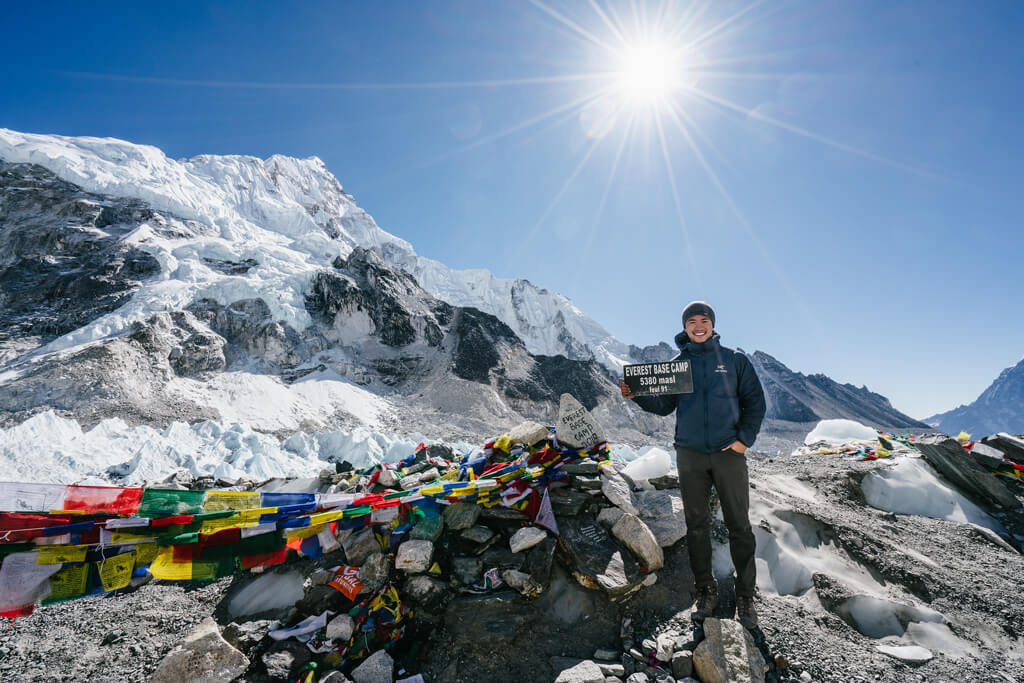
Despite the challenging weather conditions, we could identify majestic peaks, such as Mount Everest, Mt. Nuptse, Mt. Pumori, and Mt. Lingtren. We also had a glimpse of Tibetan Mountain Changtse from the summit. After reflecting on our success in reaching EBC, we returned to our tea house, where we spent the night.
Some Facts:
The name Gorakshep is a combination of two words, Gorak, which means raven, and Shep, which refers to the Sherpa people. According to local legend, the Sherpas were the first to spot dead Himalayan Ravens in the area, and they named the place Gorakshep after that incident. It is also the final destination for treks to both Everest Base Camp and Kalapatthar.
9th Day: Trek to Pheriche
After reaching EBC, our trekking party also decided to visit Kalapatthar, which was at 5550 m and took us around two hours to reach. From this vantage point, we could take in the breathtaking panoramic view of the mountains from every angle. Despite the low temperature, we relished the stunning vistas more than at EBC.
After our descent, we stopped for breakfast and checked out of the tea house to continue our journey toward Lobuche. Following the same path, we reached our lunch destination and trekked for three hours before finally arriving at Pheriche. Here, we checked in at the Panorama Lodge and Restaurant, surrounded by rocky hills and mountains, with cold and windy weather prevailing.
From the valley, we had a clear view of Mt. Amadablam, Lobuche, Tabuche, Kangtega, Cholatse, and Thamserku, all spectacular sights to behold.
Day 10: Trek to Kyangjuma
On the tenth day of our trek, we charted a different path toward Syomare. We encountered minor uphill climbs and major downhill trails, maintaining a steady pace as we traversed the rugged terrain. After crossing the Iron Bridge, we took a brief respite at Syomare for a refreshing cup of tea before continuing our journey.
As we followed the trail along the banks of the Dudh Koshi River, we noticed the emergence of green tree lines. We passed through the picturesque rhododendron and pine forests before arriving at Tengboche, where we stopped for a hearty lunch.
After crossing the suspension bridge and navigating through a few coniferous forests, we finally reached our destination for the night, the Amadablam Lodge in Kyangjuma. Here, we rested for the night after relishing a delectable dinner.
Day 11: Trek to Chumoa
Descending from the uphill, we followed the winding trails alongside the Dudh Koshi River, passing several significant landmarks such as Chorten, Mani Stone, and Stupas. Upon reaching Namche Bazaar, we savored our lunch at the same tea house where we had stayed for two nights. Following a relaxing break, we slowly ambled through the dense forest of rhododendrons and pines, passing through suspension bridges and massive prayer wheels.
Our journey led us to the TIMS checking office, where the officials scrutinized our park permit and TIMS card. After completing the necessary formalities, we arrived at Chumoa Guest House, where we checked in for a well-deserved night’s rest.
Learn more on “Everest Base Camp Trek Permits.”
Day 12: Trek to Lukla
After descending from the mountains and concluding my Everest Base Camp Trek, we retraced to Lukla, following the same trails in the opposite direction. We checked in at the tea house where we had stayed on our first day of the trek.
Day 13: Fly to Kathmandu
It sounds like you had a wonderful trip in the mountains, and it’s always bittersweet to say goodbye to a memorable vacation. Despite the weather conditions, I hope you had a safe and comfortable flight back to Kathmandu. It’s good to hear you could enjoy a final meal in the city before returning home. Thank you for sharing your experiences with me!
Related Post
Conclusion
The Everest Base Camp Trek is one of Nepal’s most famous and incredible treks, and my personal experience on this trek was unforgettable. Although it can be a moderately to strenuously challenging trek, the awe-inspiring views of the majestic mountain peaks, the natural beauty, and the warm hospitality of the local people make the difficulty worthwhile.
I hope that sharing my Everest Base Camp Trek experience has provided valuable insights and helped you plan your trek more effectively. This trek offers a once-in-a-lifetime experience that you cannot afford to miss.
If you have any further questions or concerns regarding this trek, please don’t hesitate to contact us.
